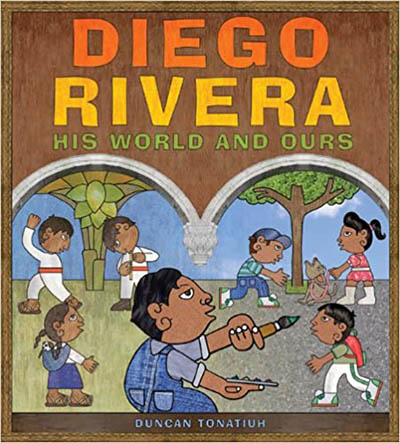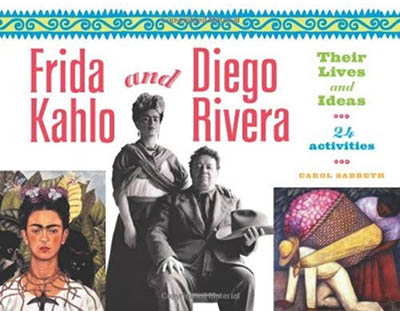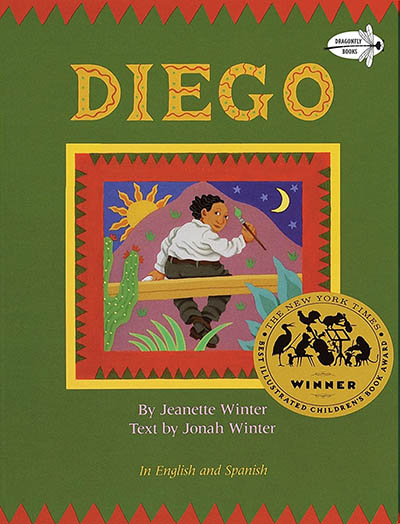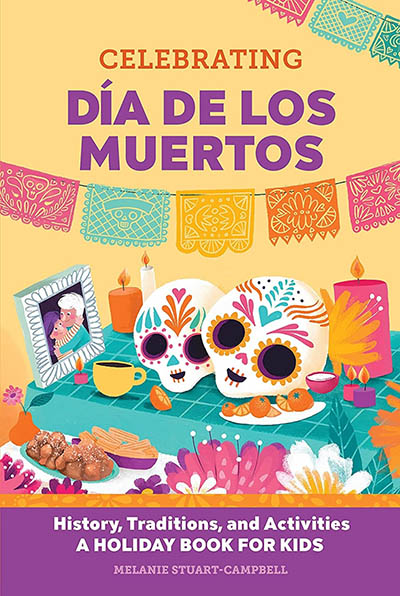Diego Rivera’s art was influenced by so many things—personal relationships, political climates, pressures in society. The kid-friendly books on this list take a closer look at Rivera’s life and use plain language to explore the circumstances that surrounded him. Many of the books also point to how Rivera’s influence remains prevalent in today’s society. We’ve also listed a few fiction books that can help kids learn more about Mexican culture and traditions. Recommended for children between 5 and 9 years old.

Award-winning Mexican author and illustrator Duncan Tonatiuh connects the past to the present in this book. Along with describing Diego Rivera’s life and greatest works, the book challenges children to consider what Rivera would paint if he were alive today. Tonatiuh describes the meaning behind Rivera’s paintings and encourages readers to tell their own stories through painting.
This book takes a light-hearted approach to describing Rivera’s early life, artistic passion, and quest for social justice. Because it’s filled with cartoon-style illustrations, elementary-aged children will find the book non-intimidating and easy to read. You can also check out other books from the Getting to Know the World’s Greatest Artists series. There are nearly 50 artist biographies with a similar light-hearted feel in this series!
With this book, families can learn about Frida Kahlo and Diego Rivera and get ideas for creating artwork based on these artists’ lives. Biographical information and activity suggestions are woven together throughout the book. Children will enjoy looking at pictures of Kahlo and Rivera, as well as pictures of their most famous works. There are 24 projects included—painting a self-portrait, designing a mural, forming an Olmec head carving, and much more. It also includes a timeline and an extensive listing of other resources. A good book for older Elementary school children.
This picture book is one of the best Diego Rivera biographies for pre-readers. The beautiful illustrations will grab their attention. Plus, the text of the book is written in both English and Spanish, Rivera’s native language. The book uses simple language, but still accurately portrays Rivera’s talents and his sympathy for the struggles of the Mexican people.
This book tells the stories of Frida Kahlo and Diego Rivera, focusing on both their time apart and the time they spent together. Middle-schoolers will enjoy learning about each artists’ accomplishments, shortfalls, and inspirations. The book insightfully tells the story of the social and political situations of the time, too. It’s packed with photographs as well as diary excerpts and letters that were exchanged between the two artists.
Young readers can get an age-appropriate, yet comprehensive, look at the life of Frida Kahlo, a prominent painter, and one of Diego Rivera’s wives. This biography is written especially for children between the ages of 6 and 9 years old. Several key themes from Kahlo’s life are brought up again and again in this book: strength, creativity, and never giving up. Readers will love the vibrant illustrations and questions that encourage them to think deeper about Kahlo’s life.
Jump into the life of dancer Amalia Hernández with this picture book and learn about another art form: dance! See what inspired Amalia to dance and the events that led her to create her own dance company, el Ballet Folklórico de México. Duncan Tonatiuh’s Mixtec-inspired illustrations in the book are full of detail and unique colors and patterns. It’s a beautiful celebration of Mexican arts and culture.
In this unique book, young readers are inspired to go beyond just looking at a piece of art. Each beautiful art reproduction is accompanied by several reflective questions that give children a chance to let their imaginations work overtime! Kids are encouraged to reflect on the artist’s inspiration, style, and the deeper story the piece of art tells. Diego Rivera’s Piñata is featured on the cover. Inside, the author gives children a look at a variety of styles, techniques, and subjects. There’s also a brief biography of each artist and information about the pieces.
Use this book to learn about the Mexican history, customs, and traditions that surround the Day of the Dead celebration. It’s a great book to use when exploring the meaning of Diego Rivera’s Day of the Dead mural. Readers will find seven chapters that each outline an aspect of the holiday. Fun illustrations and pop-out facts are sprinkled in and make the book appealing to kids ages 6 to 9. There are also suggestions for several hands-on activities that prompt kids to celebrate with their families and communities.
Take a closer look at Hispanic culture with this fictional children’s book. The story follows Pepe, a Mexican-American child. Readers are brought into Pepe’s excitement as he dresses in native Mexican costumes and joins his friends at the Hispanic Day Parade. Vivid illustrations keep children engaged, and easy-to-learn Spanish words are mixed in to give children an introduction to the language.
Follow the heart-warming story of a young girl and her grandma, her abuela. The pair take a delightful journey while flying high above the streets of New York City. As the story is told, Spanish words and phrases are seamlessly added into the narrative. The book features detailed illustrations and a sense of adventure that will capture any child’s attention. It is a great book if you have preschoolers and kindergarteners at home!
This chapter book transports children back to the 1930s. Esperanza is the daughter of a wealthy Mexican landowner, but when he dies, her mother flees with her to California. The book uses poetic language to explore the challenges that faced Mexican-Americans during the Great Depression. Children will see how Esperanza overcame challenges and found the true source of happiness.
Perfect for a rainy day or a relaxing Sunday afternoon, this coloring book features 31 pages of traditional Mexican art. Children can practice their patience as they color the intricate designs with colored pencils or markers. The pages are perforated and printed on only one side so you can easily display them if you wish.
Learn more about the artistic expression that surrounds the Day of the Dead holiday. This book describes the cultural traditions and explains several pieces of Day of the Dead art. You’ll find laughing skulls, dancing skeletons, cemetery decorations, pan de muerto, and others. Older children and adults alike will enjoy this book!













